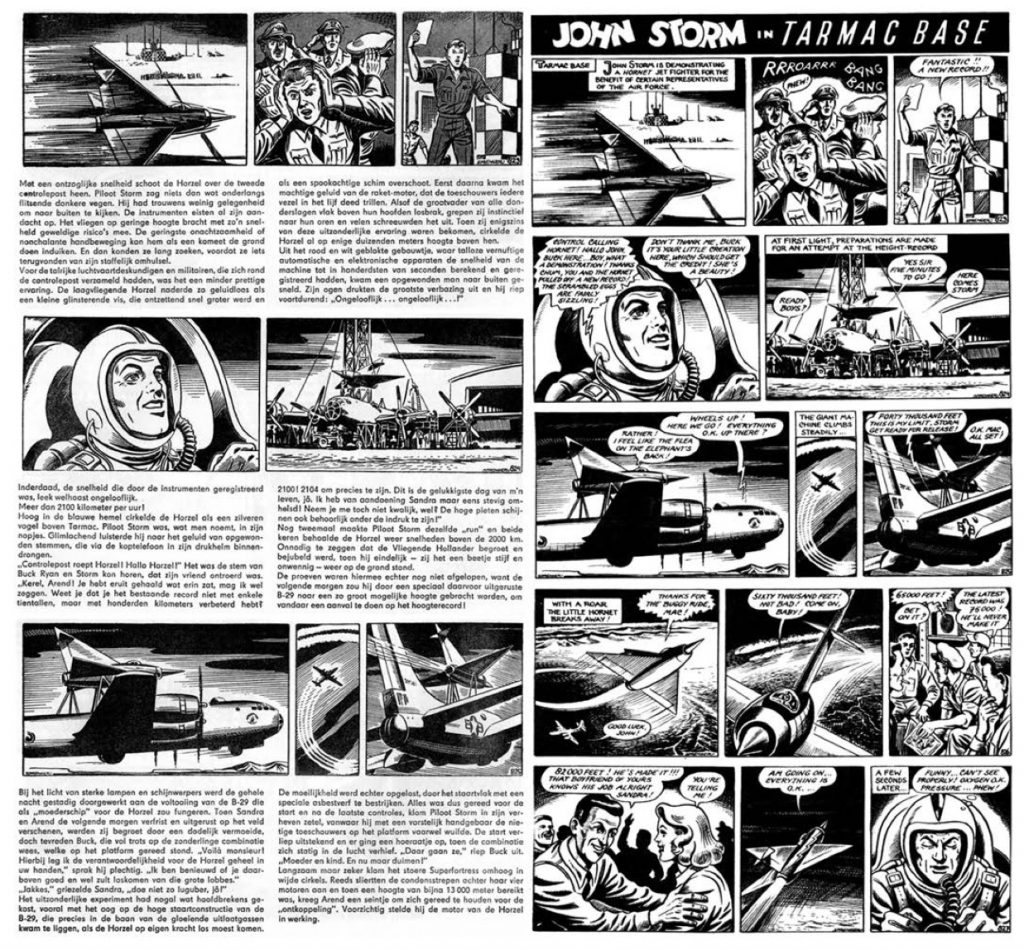By Steve Holland | Published by Bear Alley Books, 84 A4 pages | Black and white with soft colour cover

Steve Holland has previously produced highly detailed and interesting books about the British comics Lion, Ranger and Boys’ World, among others. His latest work is about Rocket, which is fondly remembered by many, despite its short life.
Beginning and ending in 1956 and running for only 32 issues, Rocket was was produced by the News of the World, which followed the Daily Mirror and the Daily Express in launching their own boys’ weeklies. Published at the same size as EAGLE, it was printed in photogravure by EAGLE’s printer Eric Bemrose and, like EAGLE, had eight colour and eight black and white pages.
As its subtitle indicates, Rocket adopted a science fiction theme throughout its pages, which contained a range of strips, text stories and informative features. Allegedly edited by the World War Two hero Douglas Bader, who is profiled in this book, the actual editor was Ross Lewis, who assembled a team of accomplished science fiction writers to contribute stories and check the accuracy of the scientific information in the weekly.
With an appealing colour cover, which reprints an episode of the back page adventure “Professor Jack Ransom” by Ley Kenyon, Steve‘s book examines all the contents of Rocket in detail, with black and white illustrations on almost every page.These include many whole pages reproduced from the weekly that give readers a clear indication of its contents and style.
The book also explores the lives and careers of all the main contributors to Rocket. Of particular interest to EAGLE enthusiasts is William F. Temple, who was previously engaged by Hulton Press to edit a proposed Dan Dare Annual which included a long Dan Dare story written by him. Although an annual was published, it contained little of the material that Temple had gathered and he expanded his unused Dan Dare story into his first Martin Magnus novel, which proved highly successful.
For Rocket, Temple wrote a humorous text series about a future school called “St. Rockets”, where the pupils are encouraged to create new inventions, illustrated by comics veteran Eric Parker.

The lead strip, which occupied the front and second pages was “Captain Falcon”, a serial story in the Dan Dare tradition. Although much better than some of the space hero strips that followed in Dan’s wake, it did not compare favourably with Frank Hampson’s work. Illustrated competently enough by Basil Blackaller (as Frank Black), it struggled to compete with Hampson and his team of gifted artists.
Rocket also included several imported strips, and Steve outlines the their histories and their creators in their native countries. They included two from the Netherlands – “John Storm”, originally “Piloot Storm”, drawn by Henk Sprenger, and “Captain Robb”, originally “De Avonturen van Kapitein Rob” drawn by Pieter Kuhn. The book shows the different ways they were set out in their Dutch and British versions, with the Dutch preferring detailed text boxes beneath each frame to speech bubbles.
The British removed the text boxes and inserted speech bubbles and much reduced text boxes into the pictures, making the reprints much more dynamic than the originals.

There were also three reprinted American strips in the weekly: “Flash Gordon”, “Johnny Hazard”, which shared the colour middle page spread, and “Brick Bradford”.
A strength of Rocket was its features, which related to space and technology. Among the highlights were “Across the Frontiers of Space”, which included an illustrated article on setting up a Lunar base, and a series called “Planning a City in Space”. The book reproduces several of these articles. There were also several reprints of technical articles from American magazines.

A short lived comic, the book fully explores the reasons for its struggle and demise, which is an interesting story in itself. There is also a brief section about the four previous comics called The Rocket from other publishers.
As in his previous books, Steve also provides a detailed index of all the comics’s content.
Obviously, the book would have benefitted from other colour pages being reprinted in colour, but this would have pushed up the price significantly. It retails at £9.99, plus £4 for postage and packing and is good value for money.
Steve Winders
• Rocket – The First Space Age Weekly is available here from Bear Alley Books
Born in Preston, Steve Winders has been a lifelong fan of Dan Dare and Eagle and of Doctor Who since its first episode. He has written many articles about the 1960s Eagle, the various incarnations of Dan Dare and the fictional exploits of the Harris Tweed Appreciation Society for Eagle Times and its predecessors and regularly reviews new works about British comics for Down The Tubes and Steve Holland’s Bear Alley blog.
He has also written articles about another interest, Robin Hood, for the online Adventures of Robin Hood Appreciation Society Magazine.
Other interests include the American West, which was inspired by the famous Eagle strip, Riders of the Range, Astronomy and soccer. He is a supporter of Preston North End. He has taught for over 40 years, in Lancashire, Mid Glamorgan and Plymouth. He is married and has three children.
Categories: British Comics, British Comics - Books, downthetubes Comics News, downthetubes News, Features, Reviews
 New book, “Harmsworth’s Comic Paper Rivals” reveals early British comic competitors
New book, “Harmsworth’s Comic Paper Rivals” reveals early British comic competitors  In Review: The Modesty Blaise Artists (Illustrators Special)
In Review: The Modesty Blaise Artists (Illustrators Special)  In Review: The A to Z of British Newspaper Strips by Paul Hudson
In Review: The A to Z of British Newspaper Strips by Paul Hudson  In Review: The Unofficial History of The Beano by Iain McLaughlin
In Review: The Unofficial History of The Beano by Iain McLaughlin